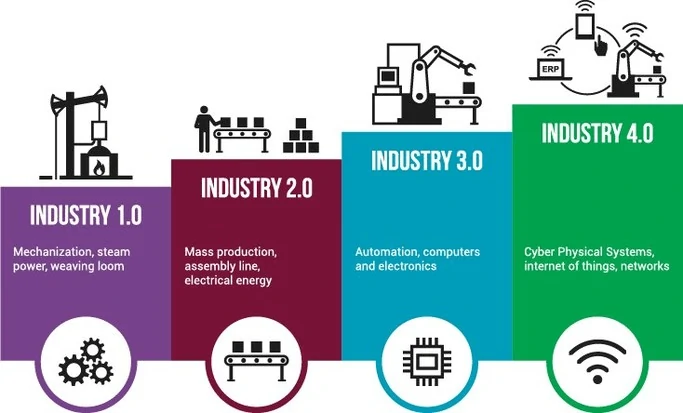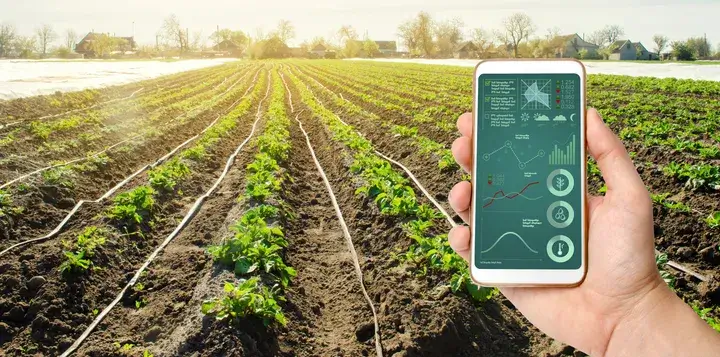Today we will discuss the growing impact of Industry 4.0 on markets, businesses sectors and people’s individual lives. Above all, what role does IoT play in the Industry 4.0?
The term Industry 4.0 is increasingly used in technology environments, but few people have a clear idea of it meaning.
The four industrial revolutions
According to McKinsey, Industry 4.0 is the next phase of the digitisation of the industrial sector through 4 disruptions:
- An enormous growth in data volume, computational capacity and connectivity.
- The emergence of new capabilities in Analytics and Business Intelligence.
- New forms of human-machine interaction.
- Improvements in the interaction between the digital and physical worlds.
At least 3 of the above 4 disruptions are closely related to IoT and smart/connected devices.
Therefore, is safe to say that the Internet of Things is the technology or set of technologies that will contribute the most to Industry 4.0.
Before we dive into how Industry 4.0 is going to take advantage of IoT, let’s look at how we got here.
If we talk about Industry 4.0 or the Fourth Industrial Revolution, it will be because there are 3 previous ones, right? Let’s see what advances each of them brought us.

First industrial revolution: mechanisation
The birth of factories and the mechanisation of the textile industry were boosted by the appearance of the coal-powered combustion engine (the steam engine) and the arrival of the railway.
This first industrial revolution was the greatest socio-economic, cultural and technological change in the history of humanity.
Second industrial revolution: mass production
The arrival of the combustion engine powered by petroleum derivatives and electric communications. Furthermore, the automobile and the airplane are developed during this period, and the telephone and radio also appear.
In addition, the industrial sector begins to use electricity and the production line is developed, led by Henry Ford and his automobile factory.
Third industrial revolution: automation
The advent of nuclear power and renewable energies enabled the rapid development of electronics and with it the development of computer and communication technologies as we know them today.
In addition, the advent of personal computers and the Internet, led to an enormous revolution. In the industrial environment, these advances led to the development of process management and automation technologies, such as PLCs and robots, which were already connected to the Internet.
Fourth industrial revolution: digitalisation
The industry in which we find ourselves immersed. It is the first revolution that is not driven by the emergence of a new energy source, but by a technological phenomenon.
This stage is accelerated by the development of smart devices and new communication technologies, making it possible to connect “things” that were not connected before. We will also be able to obtain data from different sources that we did not have before and, as an ultimate goal, to develop smart factories.
These “connected things” are the basis of what we know as IoT, the Internet of Things.
Get to know the details of the Master in the Internet of Things
IoT applications in different sectors
IoT is a very generic concept that encompasses all technologies related to the digital interconnection of everyday objects with the Internet.
These IoT technologies cover sensors and devices for acquiring information from the environment and data in real-time. They also cover communications between devices and between devices and platforms or systems in the cloud, protocols for data exchange and security of the entire system, among others.
The Internet of Things has applications in all sectors, across all industries worlwide. From its use in automated decision-making solutions, improving manufacturing and supply chain processes, to its applications in increasing the safety of operators and workers.
Examples of IoT in industry, grouped by sector, include the following:

Agriculture and Livestock
- Plantation monitoring with drones.
- Automation of irrigation in greenhouses.
- Monitoring of weather conditions.
- Tracking and traceability of livestock using geo-positioned wearables.
Energy
- Monitoring and maintenance of remote power plants or generators.
- Process automation and predictive maintenance in wind turbines.
- Demand forecasting in electrical installations.
Finance
- Improving the user experience in branches and offices through sensors and artificial intelligence systems.
- Automation of commercial processes.
- Implementation of intelligent ATMs.
Health
- Remote monitoring of vital signs and health levels of patients through the use of connected wearables.
- Personalised care in hospitals as well as outside.
- Monitoring of dependent people using geolocated devices.
Retail
- Personalisation and improvement of the user experience by identifying the user through mobile devices or wearables.
- Improvements in supply chain management.
- Intelligent inventory management or development of fully automated and self-managed shops.
Transport and logistics
- Intelligent fleet management and real-time traceability.
- Warehouse management or monitoring of sensitive or special goods through intelligent devices.
Smart Cities
- Intelligent parking and lighting.
- Improvements in waste collection.
- Increased public safety.
The role of IoT in Industry 4.0
As we have seen, IoT technology offers many possibilities and opportunities in all sectors, the sky is the limit. Nevertheless, the strongest impact of IoT is in factories with very diverse industrial applications.
When we talk about IoT in industry, we can use the term Industrial Internet of Things (IIoT).
At the beginning of this article, we have provided a definition of Industry 4.0 proposed by McKinsey, which is based on 4 disruptions. Now we are going to look at the most important IoT applications in Industry 4.0, some of which are closely related to these 4 disruptions:
Big Data and Advanced Analytics for Monitoring and Predictive Maintenance
With the advent of IoT solutions and the use of smart devices, the volume of data has grown exponentially. It is, therefore, necessary to ensure that the new data generated is properly managed and value can be derived from it.
The use of Big Data techniques for data processing and obtaining value in the industrial process, together with IoT technologies, has enabled the development of complex solutions for monitoring, predictive maintenance and automated decision-making.
This way, decisions regarding performing maintenance on a machine can now be made more flexibly. This will make it possible to carry out maintenance only when it is necessary or when it impacts the production process the least, or to delegate operation decisions to intelligent systems.
Digital Twins
Another IoT application in the industry is related to models that allow testing of how a system or machine would perform under certain conditions. Thanks to this, simulations are made with specific parameters and without affecting the real machinery.
This way, we can study and learn how to improve production processes, the limits to which we can subject a piece of equipment or the consequences of making certain configurations.
Collaborative and autonomous robotics
The advent of IoT technologies has enabled the development of robotic systems that can work collaboratively with people. This is done through the use of sensors and safety devices that ensure the integrity of workers, allowing the human-machine combination to be fully exploited.
In addition, the development of increasingly intelligent devices allows robots to operate autonomously and can even make decisions in the event of unforeseen or abnormal situations.
Industrial IoT (IIoT) Devices
The sensors and actuators that form the basis of IoT technology offer their full potential in industrial and manufacturing environments.
Applications in this field are enormous, with huge scope for improvement in production processes and cost savings by installing new sensor technology that allows data collection where it was not collected before.
The appropriate use of this data allows the development of complex monitoring systems and automated decision-making. It also offers opportunities to develop new business models around factories.
Edge Computing
For years, the trend in IT architectures has been migrating systems to the cloud. Thanks to cloud computing architecture, business services and applications can be managed by a provider through its infrastructure.
In the industrial environment, this trend is evolving towards a hybrid architecture between Cloud Computing and Edge Computing. The latter term refers to architectures in which computing and data storage capacity is brought closer to the place where the data is generated and where it will be acted upon once the information has been processed.
Although this approach puts the installation and maintenance of the on-premise IT infrastructure back on the end customer’s shoulders, there are very interesting benefits to be gained.
Cybersecurity
If the implementation of connected devices is done according to standards, the security of plants can be increased by making them smarter.
With the help of IoT equipment and solutions, it is possible to generate real-time data on the plant situation, monitor equipment and build an alert system for any unforeseen event, attack or failure.
On a more physical level, the use of sensors can help to detect any dangerous situation such as temperature rises, leaks of gas or harmful substances, abnormal vibrations, etc.
Conclusions on the role of IoT in Industry 4.0
These applications, amongst many others, use IoT technologies to improve and optimise production processes in the industrial sector. This has led to vast improvements in cost reduction and personalised / demand-driven production. It has also improved energy efficiency, increased safety and, in general, the ability to optimise production processes.
And we are still in the early stages of implementing IoT and IIoT technologies. The next few years will see solutions we can’t even imagine today.




